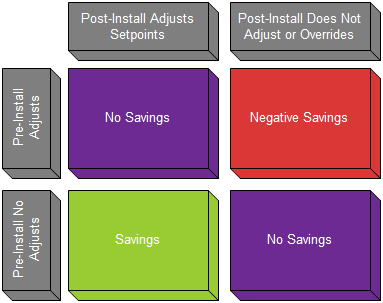Let’s skip the energy supply side this week and talk about thermostats used for cooling. Let’s broaden the discussion to include both programmable thermostats and “smart” or “learning” thermostats. The Nest falls into the latter group. Speaking for the Nest, which I have controlling my heating and cooling, it will learn user patterns by when, and to what level, the user changes temperature setpoints. It also secretly learns the users’ occupancy patterns by keeping an infrared eye on them. For instance, if the thermostat is in a heavy traffic area, it will learn to expect a lot of traffic, and when there is none, it will automatically set back by going into “Away” mode – for energy nerds, this is the same as unoccupied mode. If it is in a show-room dining area where no one ever sets foot, it will learn that as well.
Do you see why Google bought Nest? 24/7 surveillance, baby.
By the way, speaking of the unoccupied dining area; I think this may be 400 of the 3,000 square foot McMansions. I had a friend with one of these rooms back in the 1990s. No kidding, the space was cordoned off so there would be no footprints on the carpet. Dudes, that is something you do for George Washington’s home with original imported rugs that are 400 years old; not a modern-day home.
There are essentially four combinations of pre and post installation scenarios as follows (see Figure 1).
There is only one in four combinations of pre-install and post-install scenarios that results in energy savings: the customer who doesn’t give a rip about energy consumption prior to installation, and then is ok with allowing the thermostat to control temperature thereafter. These customers are pretty rare actually. In fact, a thermostat study in Michigan was just completed by Navigant, and the findings were that measured savings were actually only about 25% of projected heating savings. How interesting is that? It is likely somewhat of a coincidence, but it looks like the one in four scenario shown above. Cooling savings were actually negative. More on this later.
I would be interested in knowing the percentage of customers who adjust their thermostats before the measure is implemented. I guarantee every squeaky, tightwad, male engineer reading this adjusts his thermostat. They fall into three groups:
- The uber tightwad with the manual thermostat who is too cheap to spend money on a new one.
- The Apple haters who won’t spend money on something developed by an Apple guy (Nest was developed by such a guy).
- The squeaky tightwad who buys the wannnabe nest.
I fall into none of the quadrants above or none of the three classes of engineers. There is a statistically insignificant group of nerds in my group who like to try things, waste money on some things, and/or control things better than a “dumb” thermostat. A dumb thermostat is one with up and down arrows only, for temperature control.
My use of the Nest saves no energy. In my pre-installation case, I would adjust setpoints manually as a combination of minimizing energy consumption and comfort dictated.
The Nest, for some energy conscious nerds like me, results in increased energy use because it has such great programmability and specific control that it improves comfort with minimal extra energy consumption. In other words, it optimizes comfort while minimizing energy consumption. This is NOT energy savings.
Nest users can control the fan and the temperature, and the schedule of each independently. This is great but in my house, that means more energy use increases and comfort is optimized.
Heat rises and with an open floor plan the furnace fan needs to keep circulating air at night or it will be 5-10 degrees warmer upstairs in the sleeping rooms. This makes the usual man cave a good place for z’s. The fan can be controlled to run for any duration per hour for any length of time, independent of heating and cooling need.
Finally, that barrier of getting out of bed to change the thermostat is gone. Too cold or hot? Just grab the iPad and start fiddling.
I can see what’s happening by looking at the energy use chart below, which indicates scheduled and manual setpoint changes. I was on travel last week, so I see my wife manually flipped the Nest into “Home” mode, which activates the schedule. She manually put the Nest in “Away” when she left in the morning, as indicated by the little Monopoly house and stickman. Friday and Saturday were pretty well on auto pilot.
You can see that once the system pulls the home temperature down to setpoint at night, with no loads – no sun, no lights, no TV, etc., the temperature stays put. This leads to reasoning of programmable stats not saving cooling energy. Saturday, the oven came on to heat the baked beans for the company picnic – this can be seen as well.
My theory has long been that heat gains to a space are simply going to “pile up” until the cooling removes the heat. This would be for spaces with no free cooling by windows or fan-induced flow of outdoor air (e.g., many small commercial, residential, and hotel/motel rooms). Cooling loads are dominated by solar and internal gains, and not heat transfer through walls, as with heating. In fact, a building simulation will often times show that a more heavily insulated building requires MORE cooling energy, not less. Why? Because the impedance of heat flow from indoors back outside at night is greater.
Bottom line: programmable and smart thermostats save 75% less heating energy than projected and zero cooling energy, on a macro scale. Results vary from home to home.
